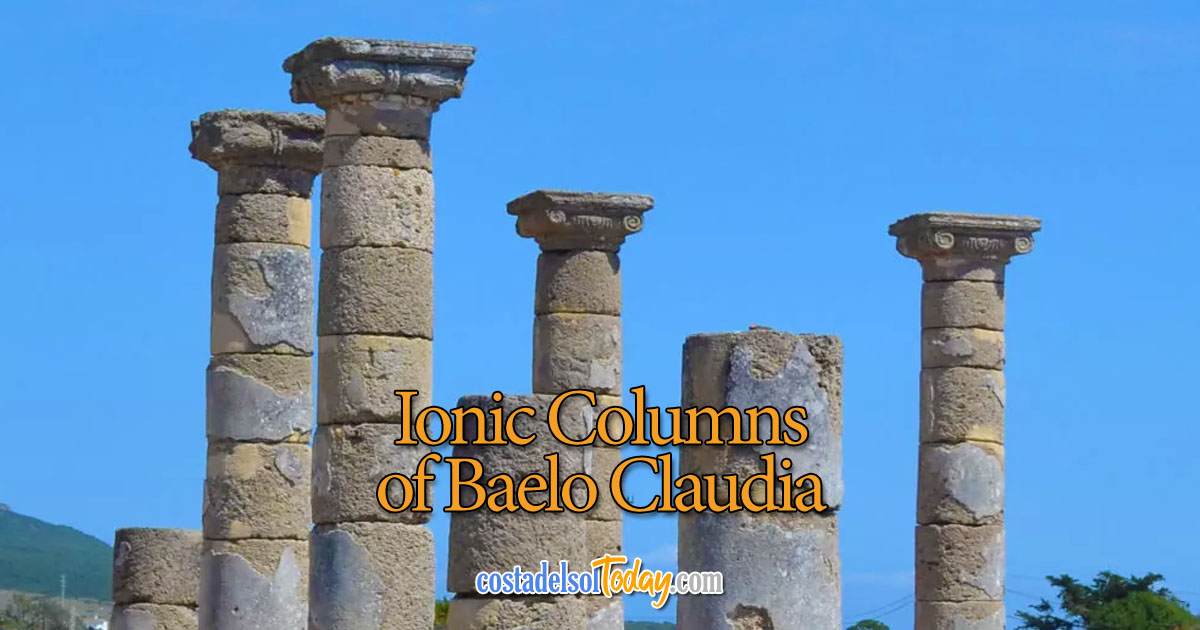Ionic Columns of Baelo Claudia Roman Ruins, Tarifa, Andalucia, Spain. Ionic columns of the basilica, Baelo Claudia, 1st century AD. The basilica was one of the major public buildings in the town. The Ionic column is typically identified by its capital, which includes large paired spiral scrolls, or volutes.


Ionic Columns of Baelo Claudia Roman Ruins, Tarifa, Andalucia
Initially a basilica was a building of a Roman Forum where the same activities which occurred in the square, including the selling of goods, were carried out indoors. Eventually it acquired a more specific purpose and it housed the tribunal and other offices of the town. The basilica of Baelo reflects this development. It had two storeys, of which only the Ionic columns of the lower one have been reconstructed. The column shaft sections were found one beside the other, which suggests they collapsed because of an earthquake in the IIIrd century AD.

The Baelo Forum is rectangular in shape and in it the political aspects of the time were discussed, as well as legal or administrative debates. To the south it was bounded by the Giudiziaria Basilica, which currently preserves the composite and Ionic columns, part of the walls and a statue of the emperor Trajan over three meters high, initially confused with the effigy of the emperor Claudius. All this erected on a rectangular base of almost 20 meters by 35.5 meters. In the Basilica the processes and the imperial cult took place.
Ionic Columns
The Ionic column is typically identified by its capital, which includes large paired spiral scrolls, or volutes. Ionic is one of three column styles builders used in ancient Greece and the Ionic order is one of five classical orders of architecture. More slender and more ornate than the masculine Doric style, an Ionic column has scroll-shaped ornaments on the capital, which sits at the top of the column shaft.
Ionic columns are said to be a more feminine response to the earlier Doric order. The ancient Roman military architect Vitruvius (c. 70-15 BC) wrote that Ionic design was “an appropriate combination of the severity of the Doric and the delicacy of the Corinthian.” Architectural styles that use Ionic columns include Classical, Renaissance, and Neoclassical.

Classical Architecture
Roman architecture continued the legacy left by Greek architects and the established architectural orders, especially the Corinthian. The Romans were also innovators and they combined new construction techniques and materials with creative design to produce a whole range of brand new architectural structures. Typical innovative Roman buildings included the basilica, triumphal arch, monumental aqueduct, amphitheatre, and residential housing block.
Many of the Roman architectural innovations were a response to the changing practical needs of Roman society, and these projects were all backed by a state apparatus which funded, organised, and spread them around the Roman world, guaranteeing their permanence so that many of these great edifices survive to the present day.
Tarifa

Tarifa – Pristine White Beaches & an 800 Year Old Castle! The pristine white beaches of Tarifa are just as majestic as the 800 year old castle that stands proudly in this southern Spanish city. Windsurfing or kitesurfing is a must, and also the sea sparkles with the promise of bustling marine life, ideal for enthusiastic anglers.
Due to the two strong winds which form the climate in this part of Spain, Tarifa became the kitesurfing capital of Europe. Dozens of schools provide classes and you purchase or rent your equipment from the browsing emporiums along Batalla del Salado, the main drag. Tarifa’s sturdy Castillo de Guzman dates from the 10th century, when it was constructed on the orders of the Caliph of both Córdoba to defend the town from invaders. It is named after Alonso Perez de Guzman, the commander who defended Tarifa from the Moorish siege at 1294, forfeiting his own son in the procedure.
In case kitesurfing sounds like way too much hard work, you may simply lie on Tarifa’s spectacular beaches instead. The two most popular are Playa de Los Lances, a mostly unspoilt stretch of sand that is free from kitesurfers throughout the summertime and, a little further north, Playa de Valdevaqueros, in which you will find some amazing sand dunes. Walk throughout Puerta de Jerez – the only one of the four medieval entries staying – and you will find yourself in the densely packed maze of whitewashed houses and pretty squares which is Tarifa’s old town. Its central sq is Plaza de Santa Maria, unofficially called Plaza de la Ranita.


